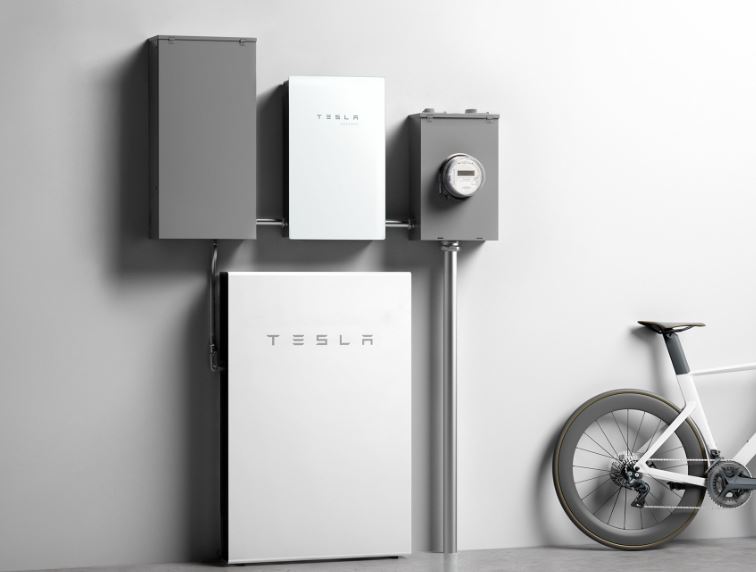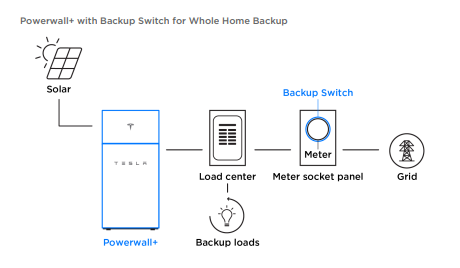Tesla Powerwall, Basics & history, Advantages. Combining solar with batteries can benefit more homeowners than ever, especially with increased energy costs and more frequent power outages brought on by severe weather.

When it comes to battery storage, the Tesla Powerwall and Powerwall+ should both be taken into consideration. This essay will provide a breakdown of the Tesla Powerwall’s features, advantages, and cost.
Tesla Powerwall Basics
The most well-known home battery available is the Tesla Powerwall. The Powerwall is the gold standard for solar battery technology because it provides an excellent blend of capability, capacity, flexibility, and software at an enticing price.
Tesla manufactures the Powerwall at their gigantic battery complex, known as the “Gigafactory,” which is located north of Reno, Nevada. Although Tesla utilises a slightly different chemistry in the Powerwall to maximise its performance as a stationary storage system, this factory also manufactures battery packs for automobiles.
All the benefits of solar batteries are present in the Tesla Powerwall, including increased energy independence, time-of-use load balancing, and backup protection against grid failures.
Additionally, the Powerwall includes market-leading software that enables homeowners to view power flows in their residence and instantly change battery settings.
Tesla Powerwall version history
There are now three different versions of the Tesla Powerwall, and a fourth one is apparently being created for spring 2023.
The Powerwall was initially a DC battery, which was released in 2015. This version has been dropped since then.
In 2016, this was closely followed by the Powerwall 2 AC battery, whose capacity was more than double that of the first model.
Early Powerwall models, like those of its competitors Sonnen and LG, contain DC batteries, making the conversion of electricity from DC to AC before it is supplied to the home or grid necessary.
Its built-in inverter for the Powerwall 2 makes configuration simpler by eliminating the need for an additional inverter. The Powerwall 2 still required a separate solar inverter to capture and store solar energy.
The most recent design is the Powerwall+. The Powerwall+ is essentially the Powerwall 2 with an integrated solar inverter. As a result, the Powerwall+ can accept DC current from solar panels directly, negating the need for yet another set of solar converters.
Powerwall 2 configuration

Powerwall+ configuration

Tesla Powerwall Specs
| CATEGORY | POWERWALL 2 | POWERWALL+ |
| Capacity (usable) | 13.5 kWh | 13.5 kWh |
| AC/DC | AC | AC |
| Max Output | 5 kW continuous / 7 kW peak | 5,8 kW continuous / 7.6 kW peak |
| Max amps of backup circuits | 30 amps | 50 amps |
| Dimensions | 45.3”H x 29.6”W x 5.8”D | 62.8″H x 29.7″W x 6.3″D |
| Stackable output? | Yes | Yes |
| TOU load-shifting? | Yes | Yes |
| Warranty | 10 Years / 70% Capacity Retention | 10 Years / 70% Capacity Retention |
| Spec Sheet | Tesla Powerwall 2 Spec Sheet | Tesla Powerwall+ Spec Sheet |
| Battery only cost (before incentives) | $7,500 | $8,500 |
Tesla Powerwall Advantages
One of the best aspects about Powerwall is stackable output. Due to the fact that Powerwall is an AC battery, its output may be increased by adding additional batteries.
As a result, while a single Powerwall generates 5kW, two generate 10kW, three generate 15kW, etc. The amperage of the backup circuits has increased. Comparatively speaking, multiple Powerwalls can support circuits up to 60 amps, 90 amps, etc. as opposed to a single Powerwall, which can only handle circuits up to 30 amps.
This performs brilliantly in comparison to DC batteries, which cannot be stacked.
The system’s overall output won’t change even if adding more DC batteries would increase the system’s storage capability and increase the amount of time it can supply electricity during a blackout. The same amount of circuit amperage that numerous DC batteries can sustain cannot be supported by a single battery.
Another important benefit of the Powerwall is its heat management mechanism. Like Tesla cars, Powerwall incorporates a liquid heating and cooling system that runs through the battery pack to maintain the proper temperature for the cells to function.
This approach improves Powerwall’s resistance and long-term performance, degradation, and durability for outdoor installations in hot regions.
Tesla Powerwall Cost
The Powerwall+ costs $11,500 with installation when ordered directly from Tesla.
That Tesla no longer sells the Powerwall separately is the real kicker. If you wanted to get the $11,5oo all-in price, you would also need to buy solar from Tesla.
Going straight through Tesla is a fantastic choice if you want to purchase solar with storage in large quantities. But, you’ll need to engage with a local installation if all you want is a Powerwall.
Normal installation fees for a Tesla Powerwall from a local installer range from $12,000 to $16,500 ($8,400 to $11,550 once the 30% federal tax credit is applied). Check out our page on solar battery pricing for more details on the factors that influence battery pricing. This contains all additional components needed for the battery to function.
Whenever homeowners buy plenty of batteries at once, installers typically reduce the price of the subsequent batteries because some of the equipment can be conserved.
Does the 30% federal tax credit apply to the Tesla Powerwall?
Yes! Any batteries with a capacity larger than 3 kWh are now eligible for the 30% Home Clean Energy Credit thanks to the enactment of the Inflation Reduction Act.
Both freestanding batteries (batteries without solar) and batteries installed into existing solar systems are now eligible for this enhanced credit.
There are local and statewide incentives available, though, including California’s SGIP programme, which offers rebates of up to $1,000 per kWh of installed battery storage.
Conclusion
Overall, Powerwall is a home battery choice that leads the industry. It has excellent qualities at a very alluring price.
When there is a power outage or you want to avoid paying high time-of-use rates, the Powerwall can store solar or grid energy. Battery storage transforms your home into a mini-utility fueled by sustainable energy when combined with solar.
Our own Solar.com customer Boris Feldman had a Tesla Powerwall 2 installed in his home. Here’s what he had to say about his new backup battery’s performance.
“The Powerwall 2 is a truly cool technological advancement that gives me complete control over how much electricity is used in our home. The smartphone app has a very clean design and is extremely user-friendly.